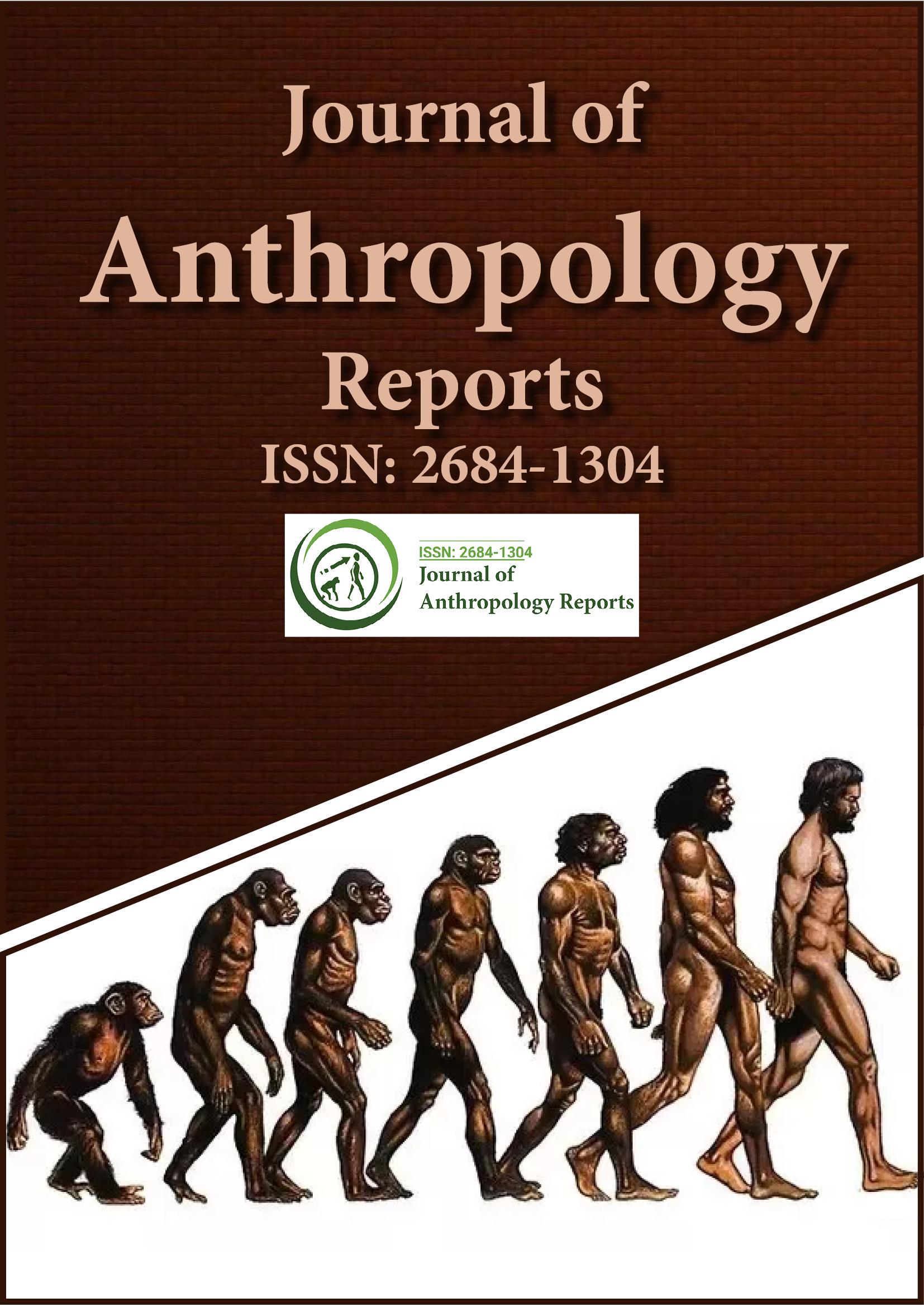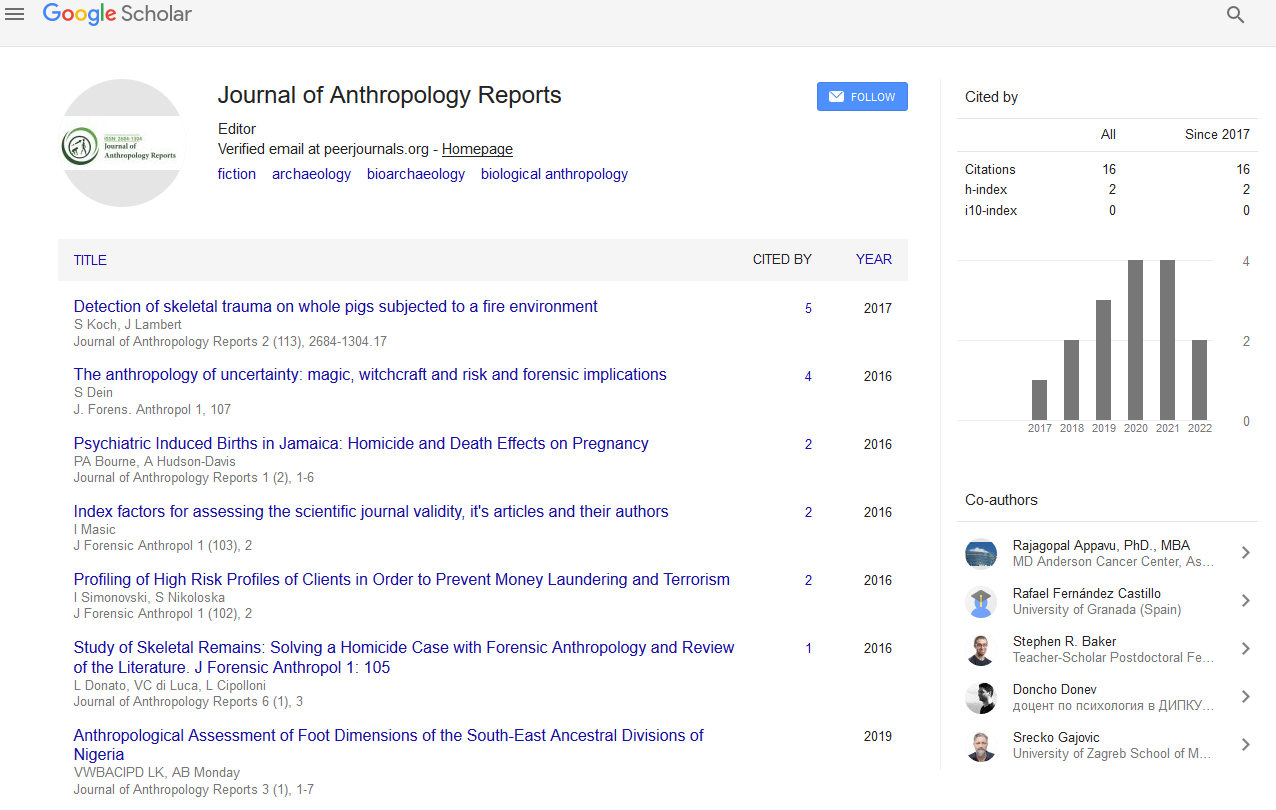Indexed In
- RefSeek
- Hamdard University
- EBSCO A-Z
Useful Links
Share This Page
Journal Flyer

Open Access Journals
- Agri and Aquaculture
- Biochemistry
- Bioinformatics & Systems Biology
- Business & Management
- Chemistry
- Clinical Sciences
- Engineering
- Food & Nutrition
- General Science
- Genetics & Molecular Biology
- Immunology & Microbiology
- Medical Sciences
- Neuroscience & Psychology
- Nursing & Health Care
- Pharmaceutical Sciences
Opinion Article - (2022) Volume 5, Issue 4
Applications of Forensic Anthropology for the Identification of Human Skeleton
Nisalsi Merry*Received: 29-Jun-2022, Manuscript No. JFA-22-17383; Editor assigned: 01-Jul-2022, Pre QC No. JFA-22-17383(PQ); Reviewed: 15-Jul-2022, QC No. JFA-22-17383; Revised: 21-Jul-2022, Manuscript No. JFA-22-17383(R); Published: 29-Jul-2022, DOI: 10.35248/2684-1304-22.5.134
Description
Forensic analysis of human remains is essential to determine the identity of the deceased as well as the cause and manner of death. They will be able to receive a respectable burial, families will receive information, death certificates will be produced, and justice will be carried out. This data can be compared to a database of DNA, dental or fingerprint records. Physical anthropology or the study of human remains has a unique subfield called forensic anthropology which uses archaeology and bone analysis to solve crimes. The systematic retrieval and collecting of physical evidence in the field; thorough scientific examination in the lab; and preservation of the evidence's integrity can all be crucial to the outcome of civil or criminal proceedings. The growth and development stages of the bones and teeth reveal if the remains belong to a child or an adult. The best indication of a person's sex comes from their pelvic bone structure. Bone abnormalities in terms of size, form or density may be a sign of disease or trauma. The cause of death can be determined by the bones that have perimortem injuries such as unhealed fractures, bullet holes, or slashes. Post-cranial remnants can reveal vital details regarding probable diseases, bone density and other traits that may also be useful. Techniques for positively identifying people have been effective in other legal contexts in addition to medico-legal death investigations.
There are various kinds of identification, including tentative, circumstantial, presumptive, and positive types. The first three methods of identification show that it cannot be ruled out that the remains or other pieces of evidence are those of a specific person. Face recognition for identification is often unreliable, especially with advanced decomposition as shown by research and case studies. Positive identification is a two-step process and has a considerably greater level of likelihood. Information used to focus the search for missing people comes from a variety of anthropological activities, such as search and recovery, species identification, sex estimation, age at death, stature, length of time since death and ancestry. First, anatomical characteristics that are shared between the analyzed data and the known antemortem details pertaining to a specific individual must be found. The second step is for the analyst to decide if the traits under comparison are sufficiently distinct to allow for identification.
Surgical procedures particularly those creating devices that remain in the skeletal tissue (the bones are routinely photographed and X-rayed) can give the distinctive traits required for positive identification. High-powered microscopes or computed tomography scanning may be used to analyze some remnants. These methods offer a visual record and extensive information about the remains without changing them. Identity may be established by DNA analysis. However, mitochondrial DNA in bones and teeth can be used to confirm links between ancient remains and deceased or current descendants. This form of testing is most frequently used in contemporary forensic casework. Certain anthropologists are proficient in facial reconstruction. This helps with the identification of the remains. Other forensic anthropologists are asked to determine the postmortem interval and pathology on the bone, including trauma. When faced with fragmented bones it may occasionally be essential for the anthropologist to reassemble the remains in order for the forensic pathologist to more clearly identify any signs of harm.
Conclusion
Advances have already been made in the field of forensic anthropology. The development of existing techniques and the development of new procedures based on the many types of cases are the only ways that forensic anthropology may advance. An investigation's identification and establishment of the identity heavily relies on forensic anthropology. The primary use of anthropology is to analyze crime scenes, examine the bones, and create a profile of the skeletal remains discovered there as evidence in court. In human rights investigations the importance of forensic anthropologists in locating the missing and bringing justice has been recognized. Investigations also serve to ensure maximum recovery and the preservation of the human skeletal remains which enables the investigation to concentrate on other lines of evidence fingerprints, fibers, DNA.
Citation: Merry N (2022) Applications of Forensic Anthropology for the Identification of Human Skeleton. J Anthropology Rep. 5:134.
Copyright: © 2022 Merry N. This is an open access article distributed under the terms of the Creative Commons Attribution License, which permits unrestricted use, distribution, and reproduction in any medium, provided the original author and source are credited.

